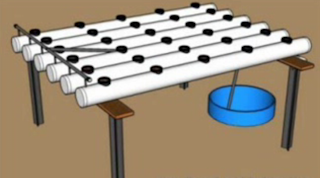

 uk2-green-legacy.blogspot.com.
uk2-green-legacy.blogspot.com.







 uk2-green-legacy.blogspot.com.
uk2-green-legacy.blogspot.com.












Plan ahead… When do you want to market your product for the best monetary return? For hydroponic tomato growers in seasonal countries, get a better price in Winter – no field competition and little from greenhouses in northern latitudes. Alternative: grow year around to maintain stable, consistent market/shelf space. Tomatoes: 2 examples of crop scheduling
Note: Concentrate on the production end (growing the plants, harvesting, marketing, etc.)
and purchase 1 month old seedlings from a TRANSPLANT GROWER.
NOTE: Why 2 crops/year? Fruit size and quality go down over time.

Control systems can be very simple or very complex. Examples include:
1) The "original" environmental control systems were manual:
2) Simple controllers operate from a thermostat in the greenhouse and:
3) Step controllers operate from a thermostat in the greenhouse and:
4) Sophisticated computers operate from a temperature sensor in the greenhouse and:
 use.
use. 
*Also refer to post Basic Needs For Fertigation 6 - Media Substrates
Pengudaraan Pasif:
 lu mahal untuk rumah lindungan secara komersial
lu mahal untuk rumah lindungan secara komersial 




 i sukar untuk lalu lalang terutama jika enclosed dengan netting. Net yang hendak dipasang mestilah dari jenis greenhouse Vege Net dgn lubang bersaiz 32 mesh dan berwarna putih seperti ini ------->
i sukar untuk lalu lalang terutama jika enclosed dengan netting. Net yang hendak dipasang mestilah dari jenis greenhouse Vege Net dgn lubang bersaiz 32 mesh dan berwarna putih seperti ini -------> ri sendiri (single built). Plastik greenhouse film boleh digunakan sebagai penutup atap menggantikan kepingan arcylic yang mahal. Guna bahan PVC sebagai struktur rangka jauh lebih murah dari menggunakan kayu dan dengan itu, kos keselur
ri sendiri (single built). Plastik greenhouse film boleh digunakan sebagai penutup atap menggantikan kepingan arcylic yang mahal. Guna bahan PVC sebagai struktur rangka jauh lebih murah dari menggunakan kayu dan dengan itu, kos keselur uhan dapat dijimatkan. PVC bersaiz tebal dan berdiameter 15" ha
uhan dapat dijimatkan. PVC bersaiz tebal dan berdiameter 15" ha nyalah berharga RM0.70/kaki atau mungkin lebih murah. Joint/penyambung 'L' & 'T' hanyalah dalam 60sen ke 70sen seunit. Gambar2 berikut saya sediakan sebagai contoh rujukan model rumah lindungan yang boleh difikirkan. Amacam Hafiz, ok tak?
nyalah berharga RM0.70/kaki atau mungkin lebih murah. Joint/penyambung 'L' & 'T' hanyalah dalam 60sen ke 70sen seunit. Gambar2 berikut saya sediakan sebagai contoh rujukan model rumah lindungan yang boleh difikirkan. Amacam Hafiz, ok tak?





 Strukt
Strukt ur2 rangka PVC
ur2 rangka PVC Jumlah = RM 82 sahaja yang sangat praktikal daripada kaedah manual (walaupun tidak perlu membayar upah). Bayangkan-bagaimana nak appoint orang untuk membuat siraman manual 5 ke 6 kali sehari bermula seawal 6.30 pagi setiap hari selama lebih dari 3 bulan? Mmm.. jenuh, jenuh. Silap-silap, ter..miss siram, pokok pula boleh layu. Banyak baja akan terbazir berbanding pengairan titis yang lebih efisyen. Seperkara lagi, jika terlalu kerap kita keluar masuk ke dalam rumah lindungan yang bertutup sepenuhnya juga tidak digalakkan. Ini adalah kerana kita mungkin akan membawa masuk serangga kecil yang melekat pada badan kita. Oleh itu, siraman secara automatik adalah alternatif yang paling efektif untuk sistem fertigasi.
Jumlah = RM 82 sahaja yang sangat praktikal daripada kaedah manual (walaupun tidak perlu membayar upah). Bayangkan-bagaimana nak appoint orang untuk membuat siraman manual 5 ke 6 kali sehari bermula seawal 6.30 pagi setiap hari selama lebih dari 3 bulan? Mmm.. jenuh, jenuh. Silap-silap, ter..miss siram, pokok pula boleh layu. Banyak baja akan terbazir berbanding pengairan titis yang lebih efisyen. Seperkara lagi, jika terlalu kerap kita keluar masuk ke dalam rumah lindungan yang bertutup sepenuhnya juga tidak digalakkan. Ini adalah kerana kita mungkin akan membawa masuk serangga kecil yang melekat pada badan kita. Oleh itu, siraman secara automatik adalah alternatif yang paling efektif untuk sistem fertigasi. semaian anak benih cili menggunakan kapas atau kertas tisu lembut sahaja seperti gambar di sebelah.
semaian anak benih cili menggunakan kapas atau kertas tisu lembut sahaja seperti gambar di sebelah. tara 25-30 hari. Apabila sudah mula menghasilkan dalam 6 daun dan pangkal batangnya menunjukkan warna perang-coklat, bolehlah dipindahkan ke point/polybeg yang siap diisi media aggrerat seperti arang sekam & coco-peat.
tara 25-30 hari. Apabila sudah mula menghasilkan dalam 6 daun dan pangkal batangnya menunjukkan warna perang-coklat, bolehlah dipindahkan ke point/polybeg yang siap diisi media aggrerat seperti arang sekam & coco-peat.Benih yang digunakan sebaiknya menggunakan benih terpilih dari jenis Precision Seed atau Hybrid seperti contoh benih di bawah. Veriety yang biasa digunakan di Malaysia ialah DRH 911, Kulai, Long Chili, Hot Chili, Kulai Susu dll. Boleh juga menyemai cili padi dan gunakan sistem pembajaan yang sama dengan cili biasa keperluan baja & kadar pertumbuhan untuk semua jenis 'keluarga' cili adalah sama (tak silap saya, Capsicum atau lada benggala pun boleh).
